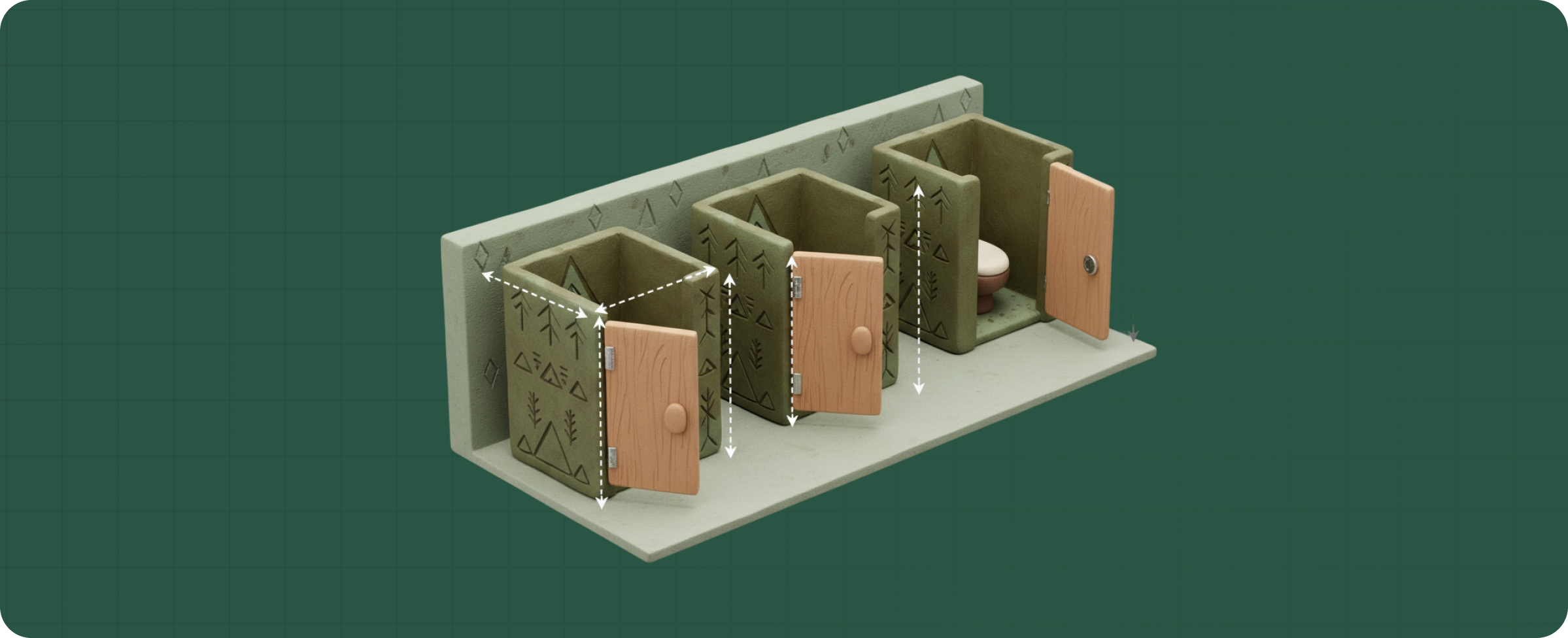What are the core spatial requirements for restroom stalls in U.S. building codes?


Bathroom stall dimensions are set by building codes to ensure accessibility, safety, and usability for all occupants. The International Building Code (IBC), International Plumbing Code (IPC), ICC A117.1 Accessibility Standard, and ADA Standards outline these requirements.
Dimensional standards
Stall dimensions vary depending on whether the stall is standard, accessible, or ambulatory.
- Standard stalls: IPC requires a minimum 30 inches wide and 60 inches deep (IPC Section 405.3.1).
- Accessible stalls: ADA Standards 604.8.1 require a minimum 60 inches wide. Depth must be 56 inches for wall-hung toilets and 59 inches for floor-mounted toilets.
- Ambulatory stalls: ICC A117.1 Section 604.8.2 requires 35–37 inches wide with parallel grab bars.
- Door clearances: ADA Section 404.2.3 requires 32 inches clear opening with doors swinging outward or sliding.
- Turning space: ADA Section 304.3 requires 60 inches minimum turning diameter within the stall.
Occupant load factors
Bathroom stall count and sizing are indirectly tied to occupant load through fixture requirements:
- IBC Table 2902.1 establishes the minimum number of plumbing fixtures based on occupancy load factors.
- Assembly occupancies (stadiums, theaters) require higher fixture counts and therefore more stalls.
- Stall width and spacing must accommodate the total number of fixtures mandated for each occupancy.
Functional criteria
Accessibility
- Turning space: 60-inch circle or T-shaped space (ADA Section 304.3).
- Grab bars: Required on the side wall closest to the toilet and behind the toilet (ADA Section 604.5).
- Clear floor space: 48 inches minimum from stall side wall to the front partition for forward transfer (ICC A117.1 Section 604.3.1).
Fire and life safety
- Separation: Partitions must be noncombustible or fire-retardant where required (IBC Section 803.11).
- Egress: Restroom compartments cannot reduce required corridor widths or egress pathways (IBC Section 1005.3).
Health and hygiene
- Ceiling height: IBC Section 1208.2 requires minimum 7 feet for toilet rooms, though partitions may be lower.
- Ventilation: IMC Section 403.3.2.1 requires 50 cfm intermittent or 25 cfm continuous exhaust per stall/fixture.
Allowable exceptions
- Reduced stall sizes: In sprinklered buildings, minor reductions may be allowed where overall clearances are preserved (local amendments vary).
- Single-user restrooms: With an outward swinging door, no stall partition is required (IBC Section 2902.3.2 Exception).
Existing buildings: ADA Section 202.3 allows compliance to the “maximum extent feasible” where full dimensions cannot be achieved.
Stall dimension requirements summary
Summary
Core stall dimension requirements ensure restroom accessibility, usability, and hygiene. Codes require standard stalls, at least one ADA-compliant accessible stall, and in some occupancies, ambulatory stalls. Stall dimensions cover minimum widths, depths, turning radii, and door clearances, with additional fire, life safety, and ventilation requirements.
FAQs
1. What is the minimum bathroom stall size required by code?
Standard stalls are typically 30 inches wide by 60 inches deep, but accessible stalls must be at least 60 inches wide.
2. How deep does an ADA stall need to be?
ADA requires 56 inches deep for wall-hung toilets and 59 inches deep for floor-mounted toilets.
3. Do all public bathrooms need an ADA stall?
Yes, at least one stall in each restroom must be ADA-compliant.
4. What is an ambulatory stall?
An ambulatory stall is 35–37 inches wide with parallel grab bars, designed for users with mobility aids.
5. Can older restrooms keep smaller stalls?
Yes, but when altered, at least one stall must be upgraded to ADA-compliant dimensions.
References
- International Building Code (IBC 2021) – https://codes.iccsafe.org/codes/ibc
- International Plumbing Code (IPC 2021) – https://codes.iccsafe.org/codes/ipc
- ICC A117.1 Accessible and Usable Buildings and Facilities – https://codes.iccsafe.org/codes/icc-a117-1
- ADA Standards for Accessible Design (2010) – https://www.ada.gov/resources/2010-ada-standards/
- International Mechanical Code (IMC 2021) – https://codes.iccsafe.org/codes/imc



%201.png)








